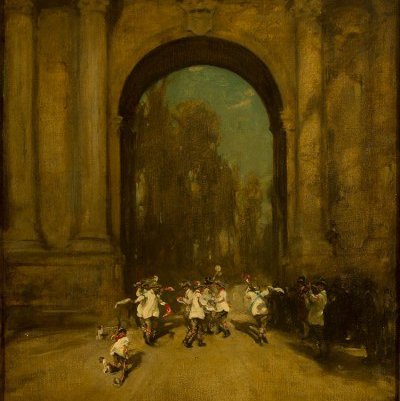29. Canterbury Quad, by William Nicholson
 William Nicholson (1872-1949), Canterbury Quad, c.1902-1904, oil on canvas, 52.1 x 57.2 cm
William Nicholson (1872-1949), Canterbury Quad, c.1902-1904, oil on canvas, 52.1 x 57.2 cm
This painting of Canterbury
Quadrangle, bathed in golden afternoon
light has something of an afternoon scene in a Venetian piazza about it – the
quiet atmosphere and strolling figures as well as the emphasis upon light and
shadow, which emphasizes the spaces behind the arches as it moves from overcast
shadow to bright sunshine from left to right across the horizontal composition.
In part, this piazza-like effect emerges from the undefined interior space of
the quad. Today, we are used to the delineations of grass and paths, but here
the close palette merges this space into the ochre sandstone of the
architecture. It could be a hazy Venetian setting from Henry James’ novel The Wings of a Dove, if it wasn’t also
so unmistakeably an Oxford quad.
Punctuated by the green of the
garden, glimpsed – as now – through the far gate under the imposing bronze
statue of Henrietta Maria by the French Huguenot sculptor, Hubert Le Sueur, the
viewer is enclosed in the scene, standing in the rich purple of the foreground
shadow that contrives to show the fourth wall of the quad, as if behind us. There are women in
the quad, but all accompanied by men (it is decades before the admission of
women to St John’s), which suggests that they are visitors, perhaps the wives
of current fellows or visitors to the college: we might conjecture that
this is a weekend or vacation afternoon, or even the afternoon of a garden
party or event.
William Nicholson himself fits
this Edwardian atmosphere. Described
by the National Portrait Gallery as ‘a
distinguished and dandified Edwardian portrait painter, poster designer and
painter of still lifes’, he was known for his immaculate attire, appearing to
paint dressed in his customary white trousers and high collar (even when
painting on the Sussex or Wiltshire downs) and clutching a folding chair.
Nicholson was also a book
designer and illustrator, and the strong, simplified black lines of his
lithographs for an alphabet book are perhaps the best known of all his works.
But he was also a wide-ranging painter, and his still-lives have a concentrated
focus upon the interrelation between objects that clearly influenced the highly
abstract work of one of sons, the modernist painter Ben Nicholson (1894-1982).
Between 1902-1904, whilst
Nicholson was living in Woodstock, he made a series of studies of Oxford,
including numerous images of the colleges. These became a series of
watercolour, chalk and pen drawings, published in 1905 by the Stafford Gallery
as two portfolios of lithographs, with descriptions by Arthur Waugh – the
father of the novelist Evelyn Waugh. Amongst these is a study of the Canterbury
Quad (see below), which informs the painting. However, in comparison to the
hazy, still scene of the painting, Nicholson’s use of line has a dynamism that lies
somewhere between the gothic drawings of the eighteenth-century Swiss painter
and draughtsman Henry Fuseli and the twentieth-century artist, John Piper
(discussed in an
earlier blog). Like both these artists, Nicholson’s line is descriptive,
animating the architectural detail of the quad such that it becomes as engaging
a subject as the actual living figure moving beneath the arches.
The cross-hatching and use of a
thick black wash turn again to the way in which light and shadow interplay
across the ornate surface of the buildings. In this lithograph there is drama
and also brevity, caused by the sense that lines have been applied with some speed
– as if following the forms of the coats of arms and the capitols as fast as
the eye traces them, securing them in this drama of sunlight and shade before
it passes. This is typical of Nicholson’s illustrative style, and it is
compelling – enchanting even. In the occasional daub of paint (such as the
flecks of white that indicate light reflected on the glass window panes) and in
the loosely painted purple shadow that dominates the foreground, there are
vestiges of this in the painting. Like Nicholson’s 1903 painting, Morris Dancers at Blenheim Gate (see
below), there is a pastoral element – the golden light and atemporality of the
morris dance evoking a crepuscular, nostalgic vision. The brushwork and the
close tonalities of these paintings also speak to the influence of the painter
James Whistler (1834-1903), who encouraged Nicholson to concentrate further
upon oil painting.
At a moment when we might begin
to hope that there is an end in sight to the pandemic, maybe we can look
forward to a summer with some echoes of Nicholson’s balmy afternoon scene in
Canterbury Quad.
 Dr Jennifer Johnson, Junior Research Fellow in History of Art
Dr Jennifer Johnson, Junior Research Fellow in History of Art

